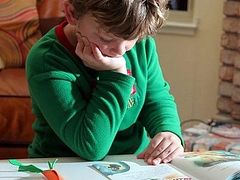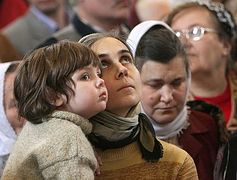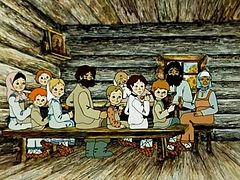“It often astonishes me when I see very spiritual and religiously educated individuals whose children have poor knowledge of the Gospel, the life in the Church, and church services… Their mothers devoted most of their time to visiting churches, priests and especially priests’ wives, observed fasts, dreamed of ascetic life and abstinence, but their children have grown up religiously incompetent ignoramuses… who know nothing about the world their own mothers sought to live in,” wrote Archpriest Gleb Kaleda (1921-1994)1.
I am quite sure that you have encountered respectable large families where children, though dearly loved, were a hindrance to their parents’ spiritual life. What can we do to ensure that the whole family can live a Church life as one? Living in megalopolises out of touch with the tradition, we find this task very difficult. Truly it is not an easy job to do.
When it comes to the major festivals like the Nativity, Pascha, Pentecost or a name day, it is not difficult to bring the joy of the festival to your home. All you need to do to make the whole family involved in it is to decorate the tree and attend a festal Church service together.
But when it comes to Great Lent, the situation is not that simple. Small children and lengthy Lenten services that require concentration and peace don’t usually go together; at least it is often hard for me, a mother of five, to combine these two. The only thing that changes for the whole period of Great Lent for all the family members is food. In some deeply religious families children observe strict fast, in other families they abstain only from meat and sweets. For us, adults, these restrictions on food are in full harmony with our awareness of the beginning of a special season which is very different from the rest of the year. A period of repentance, purification, quiet joy and prayer, when we don’t live the way we are used to. The Great Canon of St. Andrew of Crete, the Liturgy of the Presanctified Gifts along with other Lenten services help us get into the mood of the season, to remain concentrated and attentive. But our children don’t participate in all of this or participate very little. Meanwhile, life is going its usual way at home. Thus the time of Lent often passes children by, whereas it is quite possible to ensure that the whole household can participate in the life of the Church.
The use of visual methods is one of the most effective principles in developing children’s personality. In Orthodox churches different colors are used to highlight special seasons or occasions: the colors of vestments, curtains and icon decorations. Likewise, cloths play a vital role in house interiors: curtains, tablecloths, sometimes wall hangings. And Archpriest Gleb Kaleda stressed the importance of the appearance of a house where children are brought up for the rhythm of the family’s life2. In my parents’ family my mother would cover the icons of our home icon corner with a broad lace, and on Monday of the first week of Great Lent it was replaced by black cloths. We children went to an ordinary secular school where everyday life had nothing to do with the Lenten atmosphere. And these dark laces, coupled with the Prayer of St. Ephraim the Syrian at the end of the morning prayers, helped us get into the rhythm of Lent, and we would even walk to school quieter than usual on those days. These black laces on icons alone make an overall impression of your home very different, while black cloths from the beginning of Lent and bright red cloths from Holy Saturday help you switch to new “special seasons”.
In his famous book, The Year of the Lord, Ivan Shmelev (1873-1950) wrote that in his childhood curtains in the nursery had been removed for the period of Lent. My children were so impressed by this story that they suggested that we do the same in our rooms. And, indeed, without curtains we began to feel the atmosphere of Lent in our flat more intensely. By the way, rehanging curtains on Pascha adds to the festive mood of the household. It is easy to replace tablecloths for the period of Lent: for example, you can use simpler and humbler oil cloths and table mats instead of decorative and elegant tablecloths. Thus, figuratively speaking, with some minor changes in the interior the period of the forty days of Great Lent will become “visual” and “tangible”.
However, windows without curtains look bare and “dull”. We took some gouache paint (which can be wiped off easily) and painted seven steps leading up on one of the windows. On the one hand, they are a reminder of the Ladder that leads to the Heavenly Kingdom, which is commemorated on Sunday of St. John Climacus; and, on the other hand, they are a symbol of fasting as a path to God. On each step we wrote its number. As an additional educational element one can mark them not in Arabic numerals, but in Roman or old Church Slavonic (Cyrillic) numerals; if children still don’t know these symbols, then it will be easier for them to memorize them. The steps on the window lead up to “the sun”: it is both a sign of the feast and a symbol of Christ Who is the Sun of Righteousness. On gloomy days this bright, yellow sun on your window will lift the spirits of fasters. My kids cut a human figure out of thick colored paper (they intended to cut out a figure of each member of our family, but there are too many of us!) and fixed it to the bottom step with putty. As soon as the second week of Lent begins, the figure “ascends” the second step and so on until it reaches the top by the time of Pascha. After that we wash everything off. At the same time, we wash the windows and rehang the curtains before the feast. A picture of steps can be accompanied by enumeration of the seven major virtues.
Although we do have a wall calendar at home, a new tradition of making a special calendar for Great Lent originated in our family as well. And many of our friends have adopted this habit and now prepare such calendars too; this idea has proved popular and even a number of Orthodox websites have taken up this initiative3. With the help of this calendar our Lent is now more “visual”, “divided” into several stages that the kids really anticipate and experience, so fasting is becoming more “interesting”. Children prepare the calendar themselves, which means that they can remember and comprehend its contents more thoroughly. The calendar contains the following information: the duration of Great Lent, the names of its weeks, their distinctive characteristics, the “strictest” days of Lent, Church festivals celebrated during the Lent, major traditions associated with these feasts.
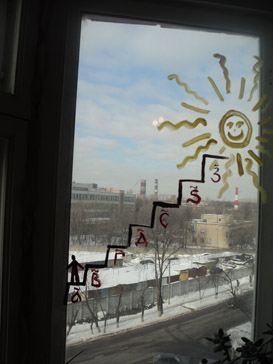
Greeks make a special doll, Kyra Sarakosti (“Mrs. Lent”) for the period of Lent5. It is a sort of “calendar” too, which helps them count the weeks of Great Lent. It is a figure that features a usual woman or a nun. The “Lady of Lent” has no visible ears as she refuses to listen to gossip, and she is depicted with no mouth as a sign that she is fasting throughout Lent. There is a sign of the cross on this Orthodox doll’s chest, while her arms are folded or reverently crossed as if in prayer. Kyra Sarakosti can also have a cross on her hair as a sign of her piety. Thus, symbolically, through this doll Greeks show the rules of conduct for Lent. Kyra Sarakosti has seven legs representing the seven weeks of Great Lent – one leg representing one week of the fasting period. Believers cut off one doll’s leg on each Saturday of Lent, so on Holy Saturday you remove the last leg.
You can draw “Mrs. Lent” on paper, sew it or make it out of dough. Many people hang it on the entrance door or near icons. My children and I made an application and cut it out, and a nice doll came out. We hung it on our entrance door so that we could keep the Lenten time in our memory right upon entering our flat. However, we have never torn its legs off!
These elements of the interior alone help the household get into the special rhythm of Great Lent. The mentioned “calendars” highlight that it is a special season. In addition, kids of different ages can easily make various domestic crafts on this subject.
Great Lent commences, and another important “visual” aspect comes with it—a special diet. Modifications are made to the “family prayer rule” as well. Children can with their mom’s help write the Prayer of St. Ephraim the Syrian in large print on white cardboard sheets: the younger children can circle the words that their mom has written in pencil with a felt-tip, while the older kids can copy the text of the prayer from the prayer-book on their own. It will be easier for the kids to memorize it this way and they will certainly look forward to reading “our home Lenten prayer”.
Putting our kids to bed, we always read them books. And during Lent this literature is special: the Lives of Saints, the Bible and so on. Parents themselves are “nurtured” spiritually through this reading. When the family gathers at the kitchen table (it usually happens at dinner in the evening as most of their fathers work), its members can read an extract from the Bible or from the Lives of Saints and then discuss it together. And this is exactly how “religious education” of children should look like according to St. John Chrysostom: the father of the family at the evening meal instructs his wife and children6.
It is very hard to attract children’s attention to spiritual talks, but there is one amazing thing: if parents are discussing something among themselves, every word that they say will be absorbed by kids. It is explained very simply: the children don’t have to go through “boring instructions”; instead they prefer to eavesdrop on grown-ups. For instance, if their mom and dad are talking about the forty years of the wandering of the Jews in the wilderness, then their children will be listening to them with excitement as if it were the most interesting adventure story. Of course, parents should be prepared for that. For example, they can choose the sermon that the father of the family heard in the morning at church as the topic of their talk (another piece of advice of St. John Chrysostom)7 or discuss one or another book. In this case a family dinner turns into a true lesson at least at the time of Lent. It is like “killing two birds with one stone”: you digest both physical and spiritual food simultaneously. It is not so difficult to arrange as it may seem at first sight, especially if you organize such “spiritual talks at the dinner table” only at weekends of the Lenten period.
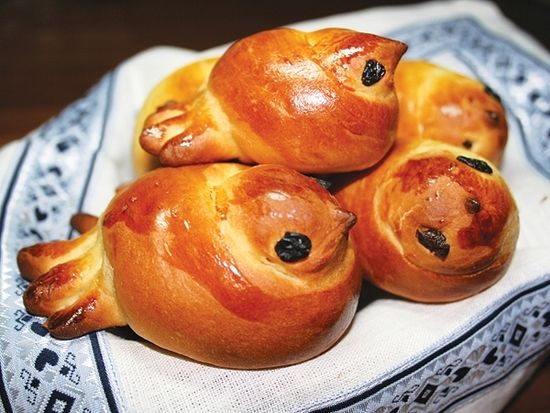 “Lark buns” baked on the feast of the Forty Martyrs of Sebaste in Russia.
“Lark buns” baked on the feast of the Forty Martyrs of Sebaste in Russia. While making the calendars, we used to underline the major Christian feasts of the season. If children are aware of these feasts, they will look forward to each of these holidays and not to the end of Great Lent. The first “interesting” festival is on Saturday of the first week of Lent, when Greatmartyr Theodore the Tyro (“the Recruit”) is commemorated and believers of a number of Local Orthodox Churches eat koliva [or “kutia” in Russia: a dish made of grains of boiled wheat usually served with raisins.—Trans.]. Following an ancient tradition, our large family eats koliva from one beautiful wooden dish. Of course, on March 22, the feast of the Forty Martyrs of Sebaste, we bake “lark buns”. Even small children can make lumps of dough and attach tiny raisin eyes to them. On the Sunday of the Veneration of the Holy Cross we bake cross-shaped cookies. On the Sunday of St. John Climacus we make pastry “ladders”, a tradition that was observed by our great-great-grandparents. One can use either home-made dough or else purchase yeast dough or flaky dough in the shops. You will have to apply only minimal efforts, but your children will greatly enjoy the joint work in the kitchen. At the same time, while baking you will have an opportunity to talk about a festival in question with your child, and this labor will serve not only as “visual aids”, but also as “edible” and “tasty” aids. Before the Annunciation we go to a bird market and buy a little parakeet in order to release it on this feast. On Lazarus Saturday we eat caviar which, as eggs, is a symbol of resurrection. Ahead of the Palm Sunday our children and I prepare a whole bunch of pussy willows. On the one hand, all these activities involve all the family members; and, on the other hand (and most importantly), it is a good chance to tell your children about these festivals, their meaning, and to start talking about more serious things8.
Thus, the fasting time indeed can be a special time for the family as a whole. Outward things help you better realize and strengthen the inward things. Lent becomes “visual”, “touchable” even for little ones. And such naïve and seemingly “secular” tasks as making “lark buns” or pastry “ladders” not only develop the children’s motor skills and serve as their first cooking experiences, but also help them form some idea of spiritual life. While three-year-olds are making ladder rungs, kids who go to elementary school are listening to the parents’ story about the Ladder of Divine Ascent by St. John Climacus and will probably want to read it. Thus our children don’t “distract” us from our “spiritual life” any more, but, rather, begin to live in the rhythm of the Church life together with adults—each in his or her own way. And the life of your family is transformed in a special way and it is not interrupted by the hustle and bustle of urban life outside the windows or in your laptop… It may seem that such trifles cannot have any effect on the life of your family. However, these are not trifles at all; in this way we take into account that man is a triune being, and the “physical” sphere – the realm of vision and sensations – matters as well.
We hope the ideas we have offered in this article or maybe some other ideas of a “children’s Great Lent” will help some people create a special atmosphere for the forty days of Lent in their homes.
And a home that is turned into “a little Church”, which fixes its eyes on “the greater Church”, will become a place of Christian education for all the family members.



